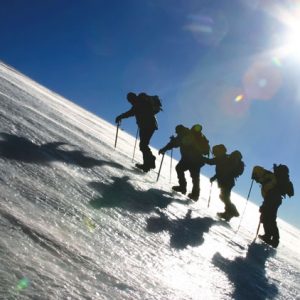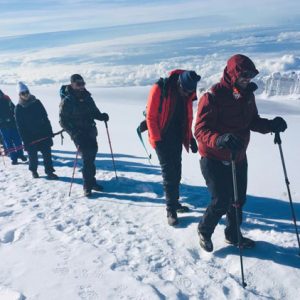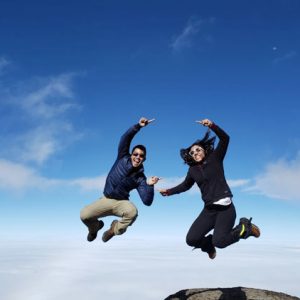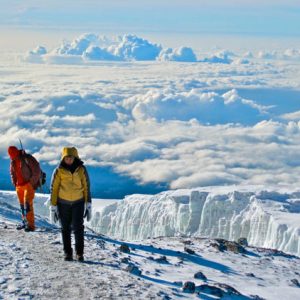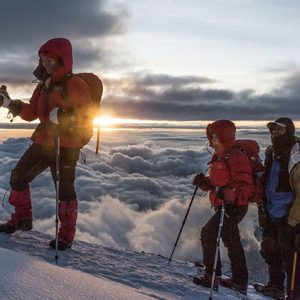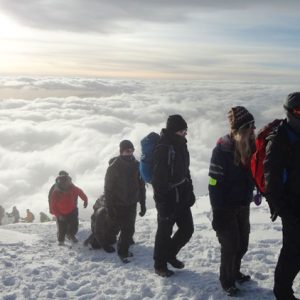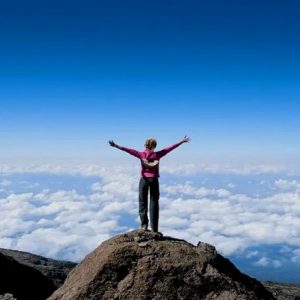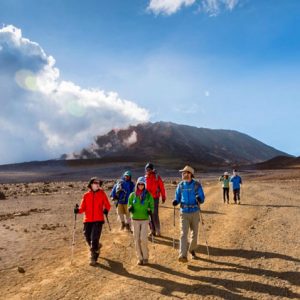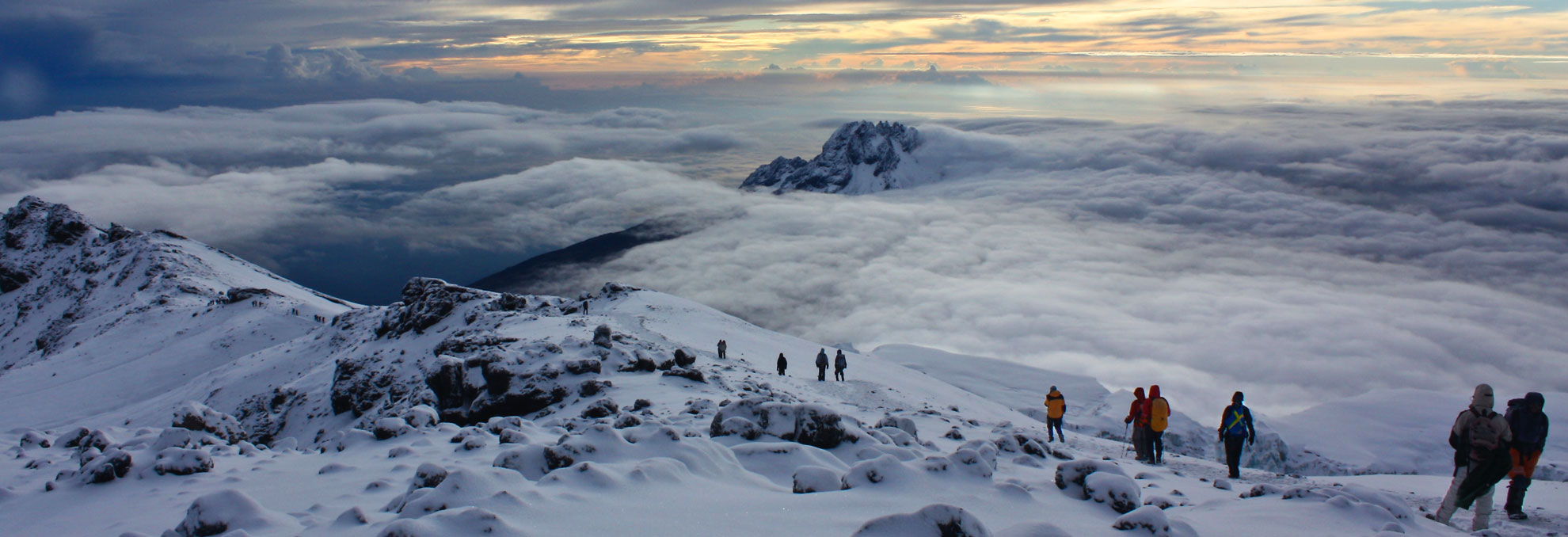
Kilimanjaro Trekking
The Climb to Africa’s Highest Peak. One of the “
Fulfill a dream – climbing up the highest and most famous summit in Tanzania. Mount Kilimanjaro stands almost 6000 meters above sea level, but one does not need to be an experienced mountain climber to reach its peak.
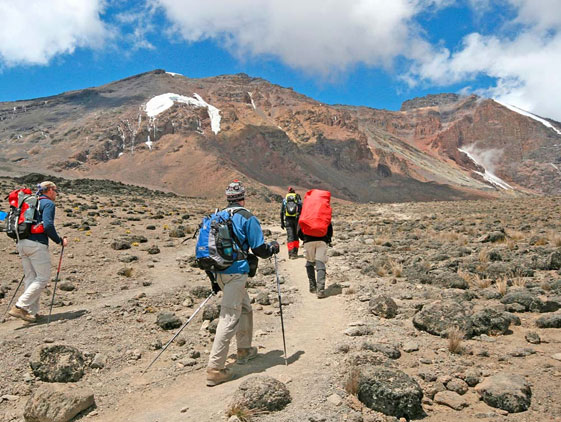
Kilimanjaro Experience
Can I Climb Mt. Kilimanjaro?
Yes, you can! Every year, over 30,000 people just like you come to Tanzania to climb Kilimanjaro, the world’s tallest free-standing mountain and Africa’s highest peak.
Mount Kilimanjaro is a place of myth and folklore. Located 200 miles (325 km) from the equator, the mountain defies logic with its crown of ice.
Climbing Kilimanjaro does not require any technical skills or special equipment, just some physical fitness and determination. People from all walks of life, from a 7 year old child to an 89 year old woman, have successfully summited. But the challenge should not be taken lightly. You need to understand what lies ahead. Rest assured, you will find the answers to all your questions here – at Guides of Africa.
Kilimanjaro Tour Packages
Come and explore Kilimanjaro with us!
Guides of Africa is one of the few specialist companies organizing high quality Kilimanjaro climbing tours. Several hundred tour operators offer Kilimanjaro climbs. However, only a handful can be considered reputable.
Kilimanjaro Informations
Get to know more About Climbing Mt. Kilimanjaro
Which Route Should I Use to Climb Kilimanjaro?
There are seven established routes to climb Mount Kilimanjaro – Marangu, Machame, Lemosho, Shira, Rongai, Northern Circuit and Umbwe. The Marangu, Machame, and Umbwe routes all approach from the south of the mountain (Mweka is used only for descent). The Lemosho, Shira and Northern Circuit routes approach from the west. The Rongai route approaches from the north. The illustrations below depict a three-dimensional view of Kilimanjaro’s climbing routes and a close up of the approaches to the summit.
Selecting a route is a tough choice for most. To find the best Kilimanjaro route for you, considerations should be taken for the route’s scenery, difficulty, foot traffic and its altitude acclimatization characteristics, as depicted in the table below. Guides of Africa has assigned overall ratings to each route.
Kilimanjaro Route | Min. Days | Rec. Days | Difficulty | Scenery | Traffic | Rating |
9 | 9 | high | excellent | very low | **** | |
6 | 8 | high | excellent | medium | **** | |
6 | 7 | medium | very good | low | **** | |
6 | 7 | high | excellent | high | *** | |
6 | 7 | high | excellent | medium | ** | |
5 | 6 | medium | good | high | ** | |
5 | 7 | very high | very good | very low | ** |
Recommended |
Good |
OK |
Not Recommended |
It is estimated that tourists climb Kilimanjaro using the routes in the following percentages: Machame (45%), Marangu (40%), Lemosho (8%), Rongai (5%), Shira (1%), Northern Circuit (0%), Umbwe (0%). In contrast, Guides of Africa clients use Lemosho (77%), Northern (10%), Rongai (6%), Machame (6%) and Marangu (1%). The reason for the difference in route popularity is that we favor the best Kilimanjaro routes – those with the most favorable combination of high success rates, excellent scenery, and low foot traffic.
Detailed route descriptions, assessments, and profiles can be found below, along with a map of each of the Kilimanjaro routes.
MARANGU (“Coca Cola”) ROUTE
Known as the “Coca-Cola” route, the Marangu route is a classic trek on Mount Kilimanjaro. It is the oldest, most well established route. Many favor the Marangu route because it is considered to be the easiest path on the mountain, given its gradual slope. It is also the only route which offers sleeping huts in dormitory style accommodations.
The minimum days required for this route is five, although the probability of successfully reaching the top in that time period is quite low. Spending an extra acclimatization day on the mountain is highly recommended when climbing Klimanjaro using the Marangu route.
However, despite its immense popularity, we avoid leading climbs on the Marangu route. The route has the least scenic variety of all the routes because the ascent and descent are done on the same path and it is the most crowded route for that reason. Marangu is favored only during the rainy season, where the hut accommodations are preferred over wet ground, or for those who only have five days to climb Kilimanjaro (which we do
not recommend anyhow). Otherwise, the Marangu route is a poor choice.
MARANGU ROUTE
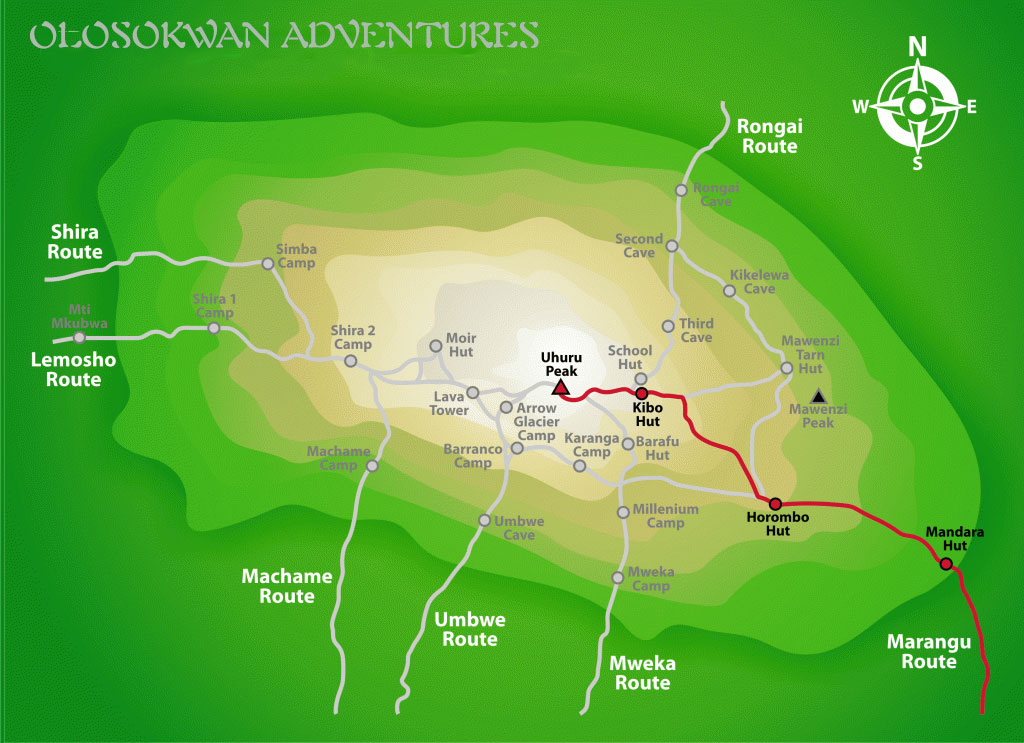
MACHAME (“Whiskey”) Route
Known as the “Whiskey” route, the Machame route is now the most popular route on the mountain. Compared with Marangu, the days on Machame are longer and the walks are steeper. The Machame route is considered a difficult route, and is better suited for more adventurous folks and those with some hiking or backpacking experience.
The route begins from the south, then heads east, traversing underneath Kilimanjaro’s southern ice field before summiting. The minimum number of days required for this route is six days, although seven days is recommended.
The Machame route is scenically beautiful and varied. However, due to the heavy crowds, it loses some of its spendor
MACHAME ROUTE
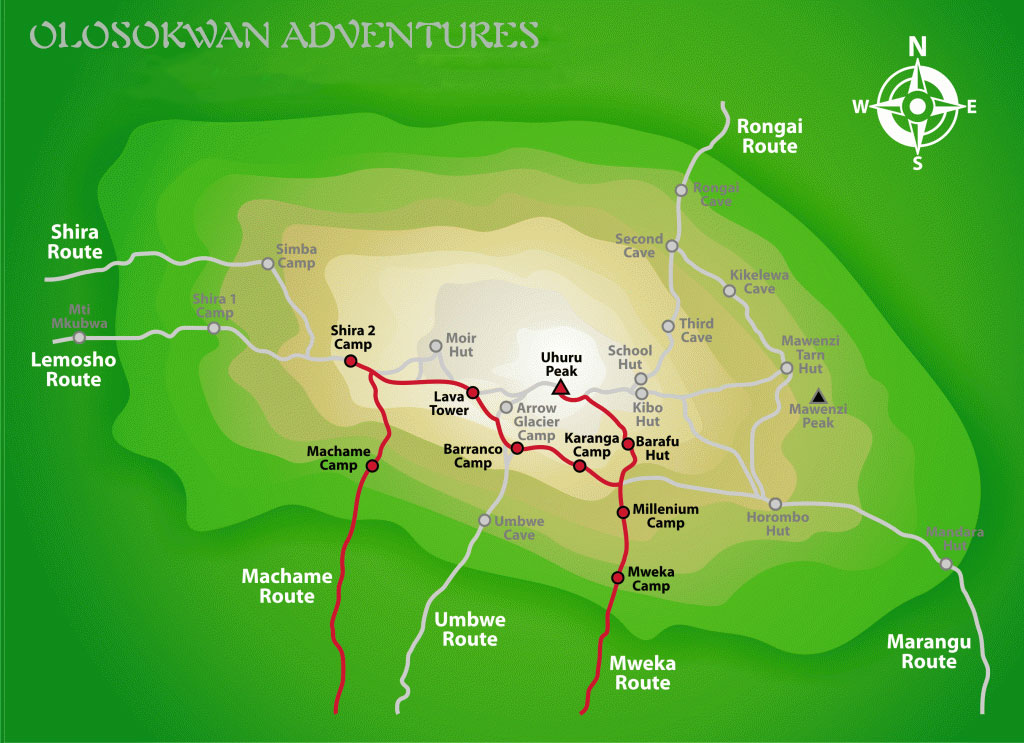
LEMOSHO ROUTE
The Lemosho route is one of the newer routes on Mount Kilimanjaro. The route begins in the west and rather than simply intersecting Shira Plateau (like Machame), Lemosho crosses it from Shira Ridge to Shira Camp. Climbers encounter low traffic until the route joins the Machame route. Afterwards, Lemosho follows the same route through Lava Tower, Barranco and Barafu, known as the southern circuit.
The minimum number of days required for this route is six days, although eight days is ideal.
Lemosho is considered the most beautiful route on Kilimanjaro and grants panoramic vistas on various sides of the mountain. It is our favorite route because it offers a great balance of low traffic, scenic views and a high summit success rate. Thus, Lemosho comes highly recommended. Most of our clients use Lemosho.
LEMOSHO ROUTE
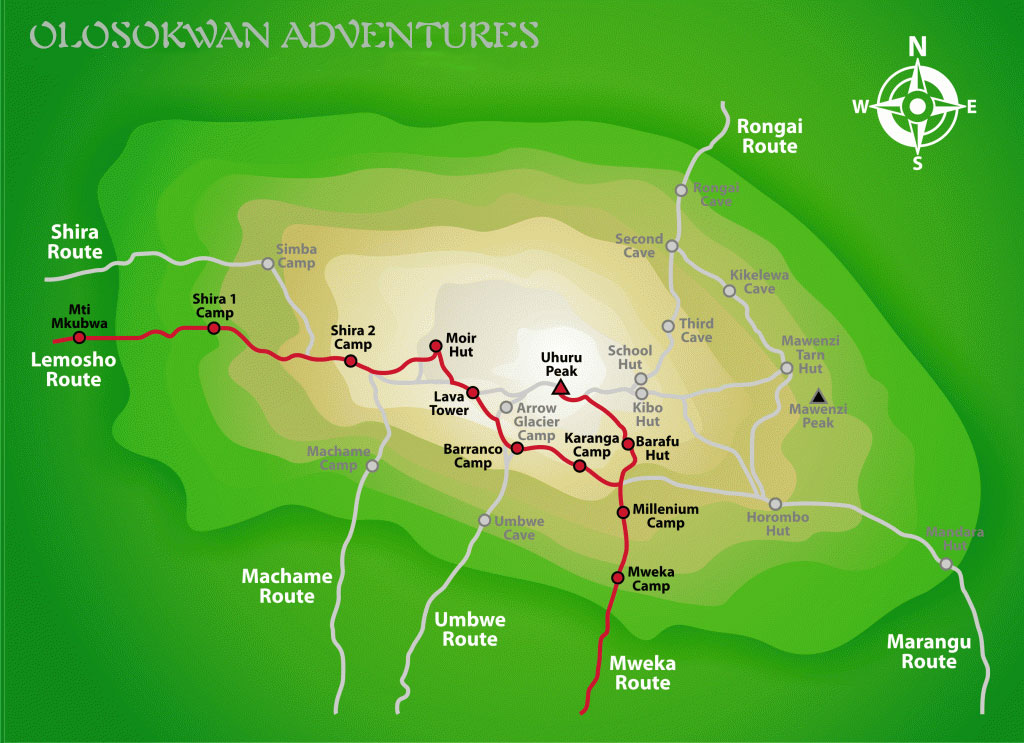
SHIRA ROUTE
The Shira route is another path that approaches Kilimanjaro from the west, and it is nearly identical to the Lemosho route. In fact, Shira was the original route and Lemosho is the improved variation. While Lemosho starts at Londorossi Gate and treks through the rain forest to Shira 1 Camp, the Shira route bypasses this walk by using a vehicle to transport climbers to Shira Gate, located near the Shira Ridge.
On the first day on the mountain, climbers begin their hike from 11,800 feet (3,600 m) and spend their first night at the same elevation at Simba Camp. Then, the route merges with Lemosho and follows the southern circuit route.
Although Shira is a varied and beautiful route, Lemosho is recommended over Shira due to the relatively high altitude of Shira’s starting point, which is accessed quickly by vehicle. It is possible that climbers will experience some altitude related symptoms on the first day while camping at 11,800 feet.
On the first day on the mountain, climbers begin their hike from 11,800 feet (3,600 m) and spend their first night at the same elevation at Simba Camp. Then, the route merges with Lemosho and follows the southern circuit route.
Although Shira is a varied and beautiful route, Lemosho is recommended over Shira due to the relatively high altitude of Shira’s starting point, which is accessed quickly by vehicle. It is possible that climbers will experience some altitude related symptoms on the first day while camping at 11,800 feet.
SHIRA ROUTE
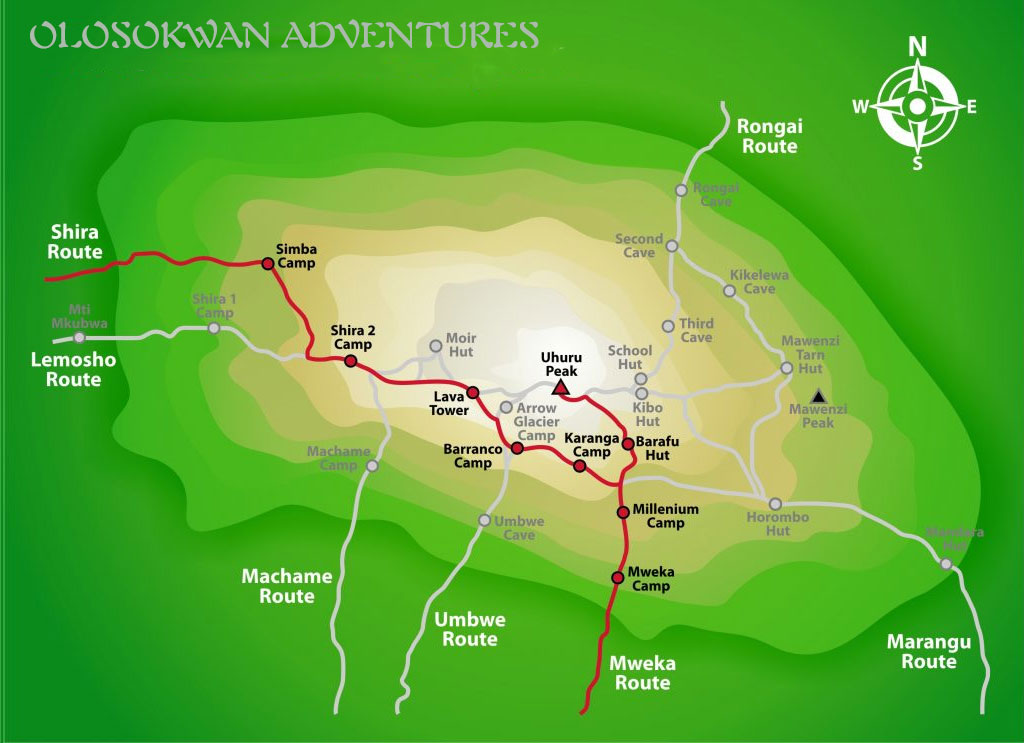
NORTHERN CIRCUIT ROUTE (RECOMMENDED)
The Northern Circuit route is the newest, most exciting route on Kilimanjaro. The trek follows the Lemosho trail in the beginning, approaching Kilimanjaro from the west. However, instead of following the southern traverse like all the other west approaching routes, the Northern Circuit traverses the mountain around the quiet, rarely visited northern slopes.
The Northern Circuit route is a nine day climb, which is the longest route in terms of time and distance travel led. The days spent at around 13,000 feet are great for acclimatization, resulting in the highest success rates for all routes on Mount Kilimanjaro.
With a high success rate, incredible varied scenery and a very low number of visitors, the Northern Circuit route is certainly one of the best routes on Kilimanjaro.
NORTHERN ROUTE
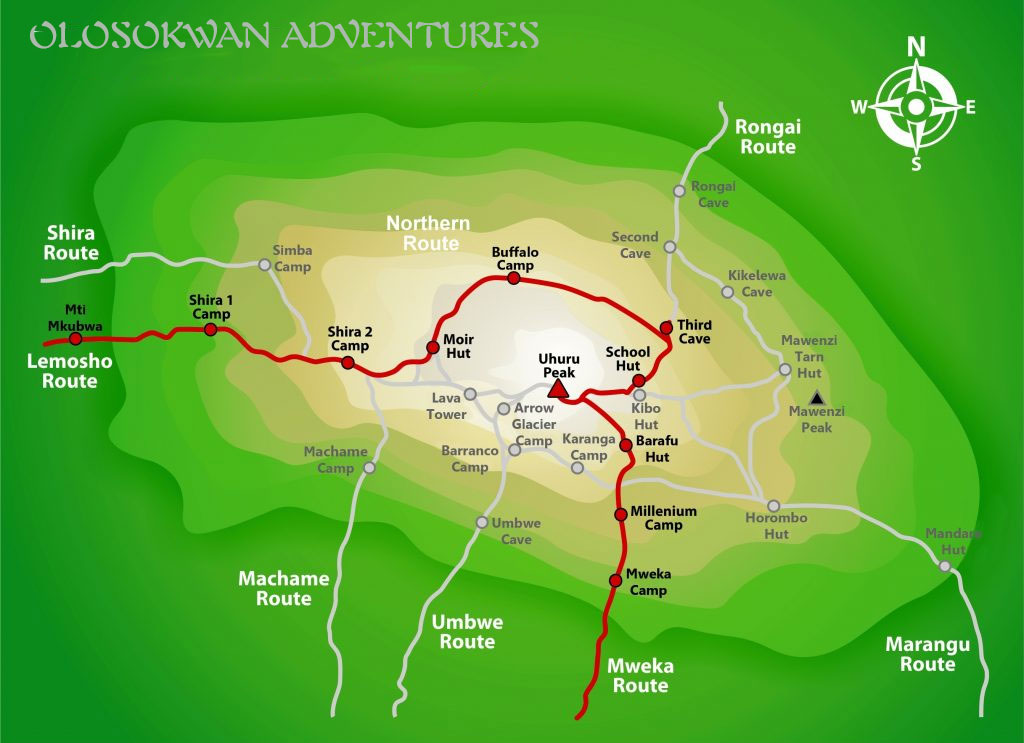
RONGAI ROUTE (GOOD)
The Rongai route is the only route that approaches Kilimanjaro from the north, close to the Kenyan border. Though gaining popularity amongst climbers, Rongai has low traffic. It is the preferred route for those looking for an alternative to the crowded Marangu route, for those who would like a more remote hike, and for those who are climbing during the rainy season (the north side receives less precipitation).
The minimum number of days required for this route is six days, and seven days are recommended.
Although the scenery is not as varied as the western routes, Rongai makes up for this by passing through true wilderness areas for days before joining the Marangu route at Kibo camp. This route descends down the Marangu route. Rongai is a moderately difficult route, and is highly recommended, especially for those with less backpacking experience.
RONGAI ROUTE
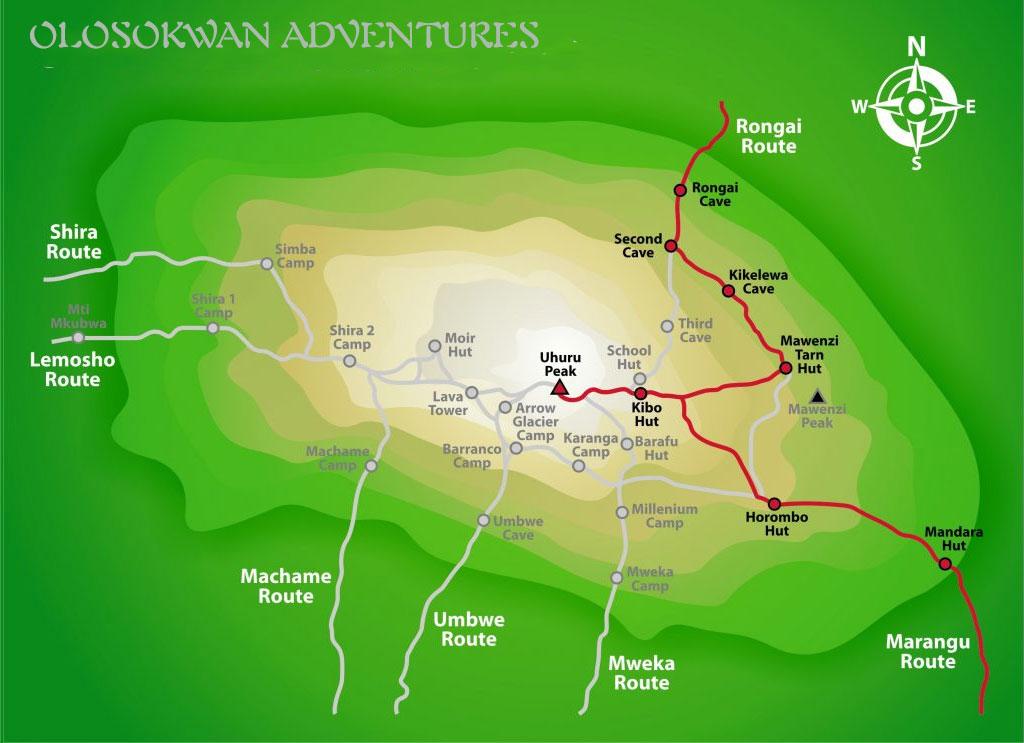
The Umbwe route is a short, steep and direct route. It is considered to be very difficult and is the most challenging way up Mount Kilimanjaro. Due to the quick ascent, Umbwe does not provide the necessary stages for altitude acclimatization. Although the traffic on this route is very low, the chances of success are also low.
The route is offered at a minimum of six days, though seven days is recommended when attempting this route.
The Umbwe route should only be attempted by those who are very strong hikers and are confident in their ability to acclimatize. However, overall, the Umbwe route is not recommended and we discourage its usage for our clients.
UMBWE ROUTE
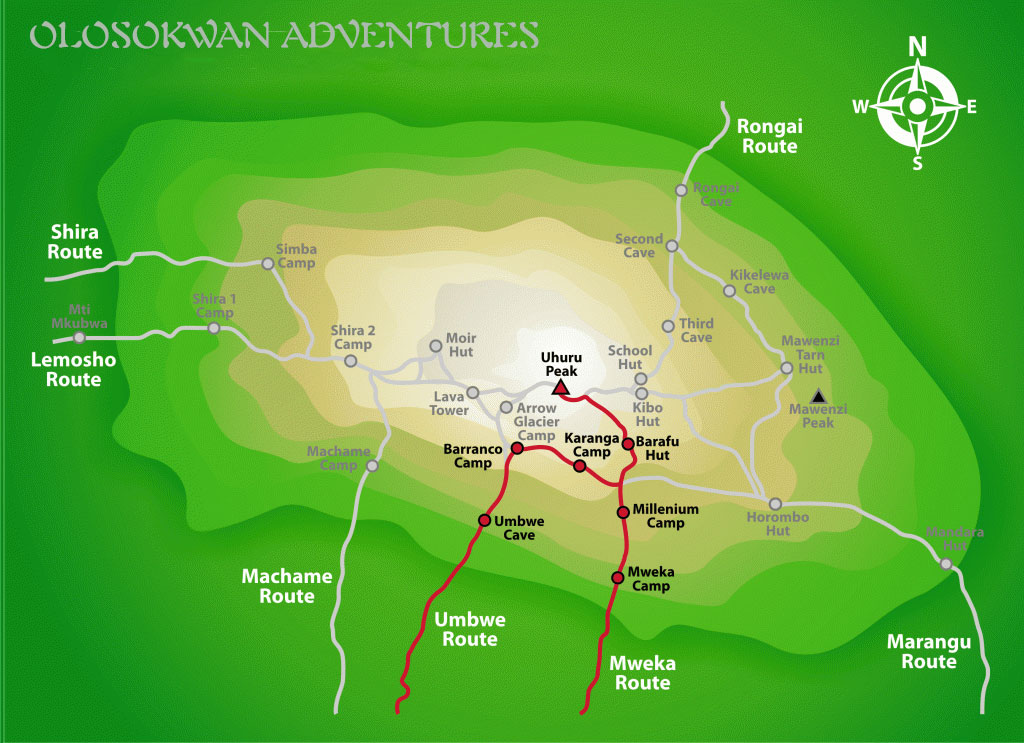
Just shy of the summit, there is a little used campsite known as Crater Camp (18,800 feet/5,750 m). It is called Crater Camp because it is a short distance from the source of Kilimanjaro herself, Reusch Crater (19,140 ft/5,800 m). Additionally, the campsite is next to one of Kilimanjaro’s last remaining glaciers, Furtwangler Glacier. Staying at Crater Camp gives climbers an opportunity to climb to the crater rim, and to get up close to the glaciers.
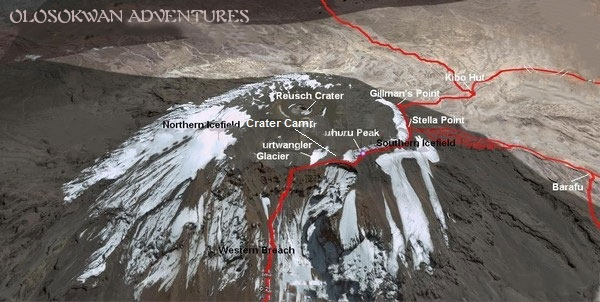
Crater Camp can be used the night before or preferably after a summit attempt. Guides of Africa operates private climbs using Crater Camp on the 9 day Lemosho route and 10 day Northern Circuit route.
![Mount-Meru[1]](https://tanzaniasafariandkilimanjaro.com/wp-content/uploads/2020/12/Mount-Meru1.jpg)
Fifty miles (80 km) west of Mount Kilimanjaro lies is an often overlooked, but spectacular volcano. Mount Meru is 14,980 feet (4,565 m) high, and serves as a great warm up before climbing Mount Kilimanjaro (19,341 ft/5,895 m). In fact, it is ideal for altitude acclimatization and you may elect to climb Mount Kilimanjaro with a lower number of days after climbing Meru.
On the mountain, there is a good chance of seeing wildlife, and the crowds that can be seen on Kilimanjaro are non-existent here. Many people who climb both mountains have a quiet preference for the humble Mount Meru.
Due to Mount Kilimanjaro’s proximity to the equator, this region does not experience the extremes of winter and summer weather, but rather dry and wet seasons.
Therefore, the best time to climb Kilimanjaro tends to be the warmest and driest months (see Kilimanjaro weather). The primary issue is safety, as the risks associated with climbing increase significantly when the weather is foul.
The effects of rain, mud, snow, ice and cold can be very strenuous on the body. Correspondingly, your chances of a successful summit also increases significantly with nice weather. Of course, the mountain gets more foot traffic during these periods as well.
The table below lists the relative temperature, precipitation, cloudiness and crowds during the calendar months.
Month | Temperature | Precipitation | Cloudiness | Crowds |
| January | Warm | Medium | Low | High |
| February | Warm | Medium | Low | High |
| March | Moderate | High | Medium | Low |
| April | Moderate | High | High | Low |
| May | Moderate | High | High | Low |
| June | Cold | Medium | Medium | Medium |
| July | Cold | Medium | Low | High |
| August | Cold | Low | Low | High |
| September | Moderate | Low | Low | High |
| October | Moderate | Low | Medium | Medium |
| November | Moderate | High | Medium | Low |
| December | Moderate | Medium | Medium | Medium |
Recommended |
Good |
OK |
Not Recommended |
it is possible to climb Kilimanjaro year round, however it is best to climb when there is a lower possibility of precipitation.
The dry seasons are from the beginning of December through the beginning of March, and then from late June through the end of October. These are considered to be the best times to climb in terms of weather, and correspondingly are the busiest months (high season). Our group climbs are scheduled to correspond with the dry season.
From January through mid-March are the warmest months, with clear skies in the mornings and evenings. During the day, clouds may appear along with brief showers. The long rainy season spans from the end of March to early June.
We do not recommend climbing during this time unless you are an experienced backpacker who has trekked in similar conditions. It can be very wet, and visibility may be low due to heavy clouds. The crowds are gone, however. From mid June to the end of October, the mountain is generally a bit colder, but also drier.
The short rainy season spans from the beginning of November to the beginning of December. Afternoon rains are common, but skies are clear in mornings and evenings.
Note that the rains are unpredictable and may come early or extend beyond their typical time frames. It is possible to experience mostly dry weather conditions during the rainy season, just as it is possible to have heavy rain during the dry season.
Some climbers prefer to summit during a full moon.
When the peak of Kilimanjaro and magnificent glaciers are lit up by the full moon, the view is absolutely stunning. For this reason alone, some climbers schedule their trek to coincide with this celestial event, occurring once a month. However, a practical reason for climbing at these times is that a bright moon along with a clear sky will improve your visibility throughout your climb, and most importantly, during the summit attempt.
Below are full moon dates:
Month | 2020 | 2021 | 2022 | 2023 |
| January | 10 | 28 | 18 | 7 |
| February | 9 | 27 | 16 | 5 |
| March | 9 | 28 | 18 | 7 |
| April | 8 | 27 | 16 | 6 |
| May | 7 | 26 | 16 | 5 |
| June | 5 | 24 | 14 | 4 |
| July | 5 | 24 | 13 | 3 |
| August | 3 | 22 | 12 | 1, 31 |
| September | 2 | 21 | 10 | 29 |
| October | 2, 31 | 20 | 9 | 28 |
| November | 30 | 19 | 8 | 27 |
| December | 30 | 19 | 8 | 27 |
To summit during a full moon, a 7-day climb should start 5 days prior to the full moon date. It is not necessary to summit on the exact full moon date to take advantage of moonlight.
A summit on the day before or day after is also beneficial. We offer several group climbs with full moon summits every month during the dry season. These dates tend to be the first to book completely full well in advance.
For those who favor a less crowded climb, avoid the full moon completely as these dates attract many climbers. Another method of dodging crowds is to choose an “off” day of departure.
Most climbers will begin their climbs on Saturday, Sunday or Monday, with routes lasting 6 to 7 days. We have many clients who climb with or without the full moon, and clients are equally satisfied with either itinerary.
You can go anytime, but do it sooner rather than later.
What makes Mount Kilimanjaro unique is that despite its close proximity to the equator, it is crowned with ice. The glaciers have existed here for more than 11,000 years.
They used to be more than 300 feet (100 m) deep and extended 6,500 feet (2,000 m) from the mountain top. However, due global warming and long term climactic cycles, the ice has been vaporizing at an alarming rate.
Some scientists estimate that Mount Kilimanjaro’s ice cap will be completely gone by 2050. So if you are contemplating the climb, do yourself a favor and do it sooner rather than later. The glaciers are something you do not want to miss.
Mount Kilimanjaro routes and their variations take between five to nine days to complete. Although Mount Kilimanjaro is known as a “walk-up” mountain, you should not underestimate it and its risks. The overall statistics show that less than half of all climbers reach the summit.
Below are the Kilimanjaro success rates as reported by Kilimanjaro National Park (2006):
All climbers, all routes 45%
All climbers, all 5 day routes 27%
All climbers, all 6 day routes 44%
All climbers, all 7 days routes 64%
All climbers, all 8 day routes 85%
All climbers, all 9 day routes (no data)
The greater the number of days on the mountain, the better your chances of reaching the top. Therefore the key to a safe, successful climb is to take the longest routes possible.
There are minimum days for each Kilimanjaro main climbing routes. However, that is not to be confused with recommended days for the route. Guides of Africa recommends adding an extra day or two to your trip to help you acclimatize to the altitude. We encourage customers to take 7-9 day routes for the best chance of success and the lowest risk of altitude sickness.
Some companies boast that their overall summit success rates are greater than 90%. We have seen competitor advertisements representing they have 95%, 98%, even 100% overall success rates. It is only a matter of time before someone advertises that they have a 150% success rate. The truth is that each of these figures are statistically impossible! Do not believe these claims!
Unless these outfitters are prescreening climbers, taking a very small number of climbers (less than 30) per year, or leading climbs only on 8-9 day routes, achieving those extraordinarily high success rates would be impossible to maintain for even a short period of time. Every outfitter knows this, but unfortunately it seems some don’t mind attracting customers with misleading or blatantly false statements.
Our primary concern is that you have a safe, enjoyable, memorable Kilimanjaro climb.
It is possible to climb the mountain in five or six days, but why take the chance? Some clients want to minimize their days in order to save costs, which is understandable.
But we feel that the additional cost is well worth it. Not only is it safer, but you increase the probability of your success, have more time to enjoy the experience, can take acclimatization hikes to other parts of the mountain you’d otherwise miss, and will probably feel better as well, given that there is less stress on your body.
Ask yourself this. How would you feel if you scheduled a route with the minimum required days, only to have to turn around within the first couple days because the rate of ascent was too quick? Wouldn’t you rather have added a couple days to your trip to give yourself a better chance, to be more fair to your body? Were the ‘savings’ you got for not taking additional days worth the cost of cutting your climb short, not making it to summit, or even worse, putting your health at risk?
